
The Near South Side is a community area of Chicago, Illinois, United States, just south of the downtown central business district, the Loop. The Near South Side's boundaries are as follows: North—Roosevelt Road ; South—26th Street; West—Chicago River between Roosevelt and 18th Street, Clark Street between 18th Street and Cermak Road, Federal between Cermak Road and the Stevenson Expressway just south of 25th Street, and Clark Street again between the Stevenson and 26th Street; and East—Lake Michigan.

Chatham is one of the 77 community areas of the city of Chicago, Illinois. It is located on the city's South Side. It includes the neighborhoods of Chatham-Avalon, Chatham Club, Chesterfield, East Chatham, West Chatham and the northern portion of West Chesterfield. Its residents are predominantly African American, and it is home to former Senator Roland Burris. Housing many city employees and other officials, Chatham has been a central area for Chicago's middle-class African Americans since the late 1950s.
Henry Wright (1878-1936), was a planner, architect, and major proponent of the garden city, an idea characterized by green belts and created by Sir Ebenezer Howard.

The Sycamore Historic District is a meandering area encompassing 99 acres (400,000 m2) of the land in and around the downtown of the DeKalb County, Illinois, county seat, Sycamore. The area includes historic buildings and a number of historical and Victorian homes. Some significant structures are among those located within the Historic District including the DeKalb County Courthouse and the Sycamore Public Library. The district has been listed on the National Register of Historic Places since May 2, 1978.
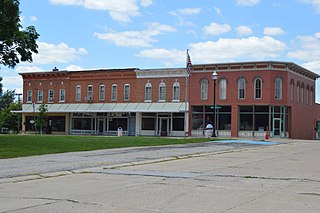
Barry Historic District is a historic district comprising the commercial and older residential areas of Barry, Pike County, Illinois. Barry was founded as an agricultural community in the 1830s, and most of its development took place between its founding and the Civil War. The city's commercial core, however, was mainly built in 1894 after a fire destroyed most of the existing commercial buildings. The 1894 buildings are well-preserved examples of typical commercial architecture of the period, and several have metal storefronts. The district also includes Barry's "Diamond Hill" residential district on Mortimer Street east of Brown Street and several other residential sections. Prominent architectural styles in the residential areas include Italianate, Queen Anne, Carpenter Gothic, and vernacular types from the late 19th century.

Griggsville Historic District is a historic district comprising the oldest sections of the city of Griggsville, Pike County, Illinois. The district encompasses Griggsville's commercial center and two of its residential areas. Development began in the commercial center in the 1830s; however, most of its significant buildings were built between 1850 and 1880. These buildings are mainly two-story brick structures, and several have Italianate influences. The southern residential area also has a heavy Italianate influence, as most of the homes there are designed in the style. The northwest residential area includes a variety of architectural styles and has a more rural character.

Downtown Oklahoma City is located at the geographic center of the Oklahoma City metropolitan area and contains the principal, central business district of the region. The CBD has over 51,000 workers and over 12,000,000 sq ft (1,100,000 m2) of leasable office space to-date. Downtown Oklahoma City is the legal, financial, economic, nightlife, and entertainment center of the region.

Downtown Omaha is the central business, government and social core of the Omaha-Council Bluffs metropolitan area, U.S. state of Nebraska. The boundaries are Omaha's 20th Street on the west to the Missouri River on the east and the centerline of Leavenworth Street on the south to the centerline of Chicago Street on the north, also including the CHI Health Center Omaha. Downtown sits on the Missouri River, with commanding views from the tallest skyscrapers.
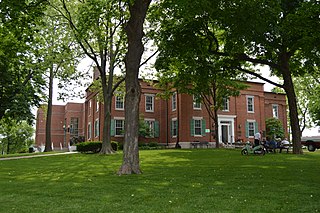
The Waterloo Historic District is a historic district composed of the majority of central Waterloo, Illinois. The district includes 271 buildings, of which 182 are contributing buildings to its historic character. The center of the district includes Waterloo's town square, the site of the Monroe County Courthouse, as well as a two-block section of Main Street which forms the city's commercial core. The town square is surrounded by residential development on three sides, an unusual arrangement among small towns in Illinois. The predominant architectural styles in the residential parts of the district are local adaptations of the Federal style and a German cottage style developed by the city's German immigrants in the 19th century.

The Galena Historic District is a historic district located in the city of Galena, Illinois, USA. The historic district encompasses 85 percent of the city of Galena and includes more than 800 properties. The downtown area consists of three successive tiers made up of Main, Bench and Prospect Streets. Within the boundaries of the district are such notable homes as the Ulysses S. Grant Home and the Elihu B. Washburne House. The Galena Historic District was added to the U.S. National Register of Historic Places in 1969.

The Jacksonville Historic District encompasses the historic core of the 19th-century mining town of Jacksonville, Oregon. The city was a major mining, civic, and commercial center from 1852 to 1884, and declined thereafter, leaving a little-altered assemblage of architecture from that period that is unparalleled in the Pacific Northwest. The district was designated a U.S. National Historic Landmark in 1966.

The Torringford Street Historic District is a historic district on the east side of the city of Torrington, Connecticut. The district includes properties along Torringford Street, the main thoroughfare of the Torringford section of the city, between United States Route 202 and West Hill Road. The road is one of the oldest in Torrington, and this section is notable for containing a cross-section of well-preserved architecture from the 18th to the mid-20th centuries. The district was listed on the National Register of Historic Places in 1991.

The Greenwich Avenue Historic District is a historic district representing the commercial and civic historical development of the downtown area of the town of Greenwich, Connecticut. The district was listed on the National Register of Historic Places on August 31, 1989. Included in the district is the Greenwich Municipal Center Historic District, which was listed on the National Register the year before for the classical revival style municipal buildings in the core of Downtown. Most of the commercial buildings in the district fall into three broad styles, reflecting the period in which they were built: Italianate, Georgian Revival, and Commercial style. The district is linear and runs north–south along the entire length of Greenwich Avenue, the main thoroughfare of Downtown Greenwich, between U.S. Route 1 and the New Haven Line railroad tracks.

Four Corners is the intersection of Broad and Market Streets in Newark, New Jersey. It is the site of the city's earliest settlement and the heart of Downtown Newark that at one time was considered the busiest intersection in the United States. The area that radiates 22 square blocks from the crossroads is a state and federal historic district.
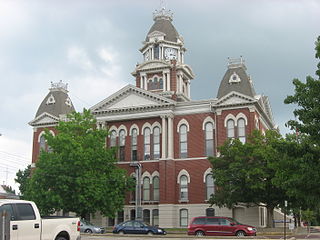
The Shelbyville Historic District is a historic district encompassing the core of Shelbyville, Illinois. The district includes 398 buildings, 293 of which are contributing buildings. The section of Shelbyville laid out at the city's founding in 1827 forms the center of the district. Shelbyville's public square, which includes the 1880 Shelby County Courthouse and a veterans' memorial, is the central feature of this part of the historic district. The original section of Shelbyville also includes significant commercial and government buildings. The district also includes Shelbyville's oldest residential areas, which developed out from the 1827 core. The Italianate style is the most prominent architectural style in the district, both in homes and commercial buildings; other common architectural styles include Greek Revival, Gothic Revival, Second Empire, and Queen Anne.
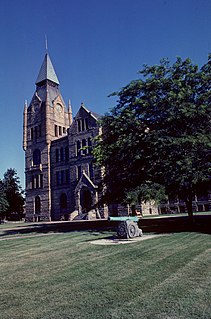
The Galesburg Historic District is a 496-acre (201 ha) historic district in Galesburg, Illinois. The district includes 1049 contributing buildings and contains the town's original plat as well as several older neighborhoods. The section of the district south of North Street encompasses Galesburg's historic city center and its most significant landmarks, such as the Knox County Courthouse, the Knox County Jail, the Burlington Depot, and Main Street's commercial buildings. Knox College, the school Galesburg was founded to serve, and its historic Old Main are also located in the southern half of the district. The area north of North Street is mainly residential and is dominated by Queen Anne and Classical Revival houses, including many transitional houses displaying elements of both styles.
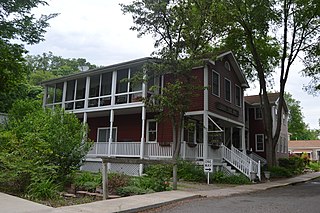
The Elsah Historic District is a 350-acre (140 ha) historic district in Elsah, Illinois. The district includes 48 contributing buildings which reflect the village's period of growth in the 1850s. Elsah was founded in 1853 as a riverfront town on the Mississippi River; by 1861, it had grown to its current size, as geographic and economic limitations prevented further expansion. The town's 1861 appearance is well-preserved, and three distinct areas of the town have gone almost entirely unchanged since. The historic commercial district on LaSalle Street, which extends three blocks inward from the river, consists mainly of stone buildings; all but one of its pre-1861 buildings, including all four of the village's historic taverns, still stand. The other two districts are both located on Mill Street and are primarily residential; the larger one is three blocks long and has an assortment of stone and brick houses, while the smaller section has a single block of Greek Revival homes.
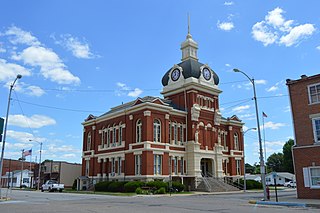
The Winchester Historic District is a historic district which encompasses much of the developed area of Winchester, Illinois. The district includes 438 buildings, of which 273 are contributing buildings. Winchester's historic area represents a typical small, rural county seat; its commercial development is focused around the county courthouse and town square, while low- to moderate-density residential development can be found away from the commercial center. Development in the district began in the 1830s; by the 1870s, most of the significant buildings had been completed. The district's older buildings are mainly designed in the Federal and Greek Revival styles, while its later buildings mostly have Italianate designs. The Greek Revival Presbyterian Church stands out among these traditionally-styled buildings; according to the Illinois Historic Structures Survey, it is the most exceptional Greek Revival church in any Illinois city of over 500 people. The Scott County Courthouse, a late addition to the district in 1885, has also been noted as architecturally significant, though its design does not conform to a single style.

The Walnut Street Historic District is a nationally recognized historic district located in Waterloo, Iowa, United States. It was listed on the National Register of Historic Places (NRHP) in 2019. At the time of its nomination the district consisted of 111 resources, including 91 contributing buildings and 20 non-contributing buildings. The district is largely a residential area located between the central business district and the former location of the Illinois Central Railroad round house and shops. The neighborhood was originally platted as the Railroad Addition in 1860 and as the Cooley Addition in 1865. Buildings date from c. 1880 to 1981. Single-family houses are largely wood-frame construction with a few brick. Architectural styles include Queen Anne, Italianate, Shingle, Bungalow, variations on the American Foursquare, and those in a vernacular mode. Multi-family dwellings include double houses, identical houses, and apartment buildings. There are also a few commercial buildings on East Fourth Street and two churches. Walnut Street Baptist Church (1908) is individually listed on the NRHP. Two local architects, Mortimer Cleveland and Clinton Shockley have buildings in the district.
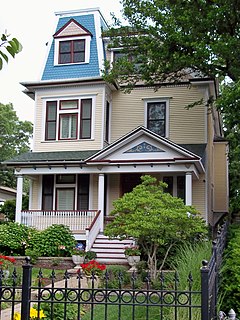
The Sheridan Park Historic District is a residential historic district in the Uptown neighborhood of Chicago, Illinois. Developed between 1891 and 1929, the district is a collection of single-family homes, small apartment buildings, and a handful of larger apartment hotels. The homes were built early in the district's development, with nearly all of them completed by 1910; at the time, the district was planned as a spacious suburb and categorized with North Shore communities. The apartments were all built in the twentieth century as the dense city core of Chicago expanded into the district. The district includes a large collection of six-flat apartments in particular; small apartments such as these, which were only three stories tall, fit neatly among the single-family houses of the original neighborhood.





















